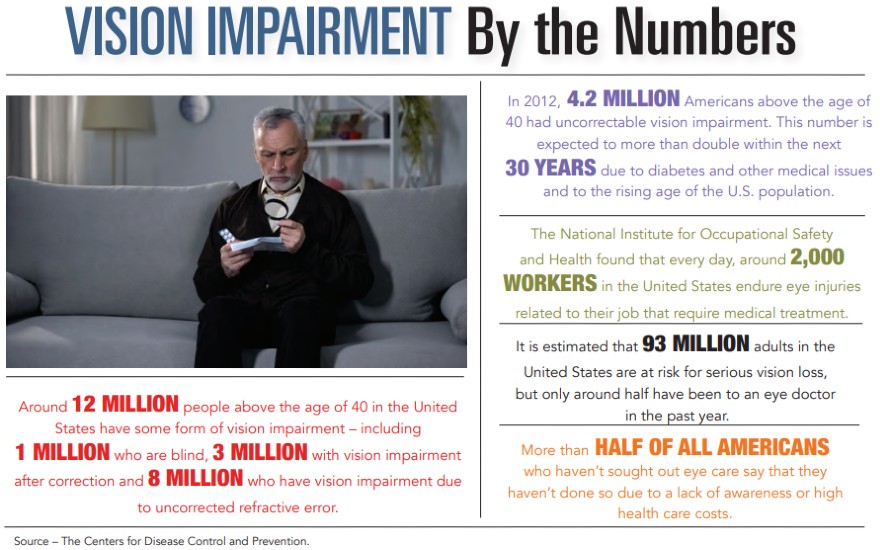It’s estimated that at least 2.2 billion people around the world suffer from some type of vision impairment. This issue affects people of all ages, although it is much more common in people over the age of 50.
But vision impairment doesn’t have to be entirely debilitating. With help from an occupational therapist, people with low or no vision can find ways to make the problems that arise in their daily lives much easier.
Stasi Gormley is a Mount Pleasant-based occupational therapist with a specialty in low vision therapy. Her work helps people suffering from vision impairment learn how they can continue to handle daily tasks such as reading the paper and preparing food, enjoy their hobbies and stay connected by finding ways to see screens and keyboards.
“The people I work with are primarily seniors and some adults that, for the most part, have lived an average life until they had some type of visual diagnosis happen where they can no longer use regular eyeglasses or prescriptions to see things up close, intermediate distance or far away,” said Gormley.
“The majority of people I work with have difficulties with reading mail, newspapers, books or magazines but also reading the computer or a phone screen. They may have a hard time being able to operate appliances in their house. Most of the people I see have vision loss to the point where they now can no longer drive and need help knowing how to get transportation to the places they need to go,” she added.
Gormley works with her patients in their homes, making the occupational therapy process more accessible and helping them to re-learn how to complete their daily tasks. Being in patients’ homes and seeing how they can manage their vision loss also gives Gormley a better idea of their needs.
“I receive doctors’ referrals from retinal specialists, glaucoma specialists, ophthalmologists and sometimes optometrists,” said Gormley. “When I receive the referral, I already know what the visual diagnosis is, then I call the patients and set up an appointment for an in-home low vision evaluation. My first appointment is up to two hours.”
The questions Gormley asks during the initial evaluation concern what the patient’s typical day is like. Can you put toothpaste on a toothbrush? Can you cook a meal? Can you see your clothes to get dressed? She does a contrast assessment where she determines if the patient can differentiate the foreground from the background in different lighting conditions or if there is a problem with glare. She also tries to get a good idea of a patient’s ability to read specific sizes of newspaper print.
Many people with low vision lose some of their independence and confidence when they are no longer able to continue living their lives as they once did. Gormley addresses this issue when she shows patients how to adapt their daily activities to their vision level, but she also discusses coping skills and self-management tools, such as social support from family members or community resources.
Part of managing vision impairment is learning how to communicate with others and finding ways to control the emotions that can accompany vision loss. One of the biggest issues that can come with vision impairment is the inability to drive, but patients might also be unable to participate in their favorite activities and hobbies.
“Then you have to look at adapting activities or exploring new activities to get involved in,” said Gormley. “Those are many of the things that I discuss and the process I go through during an evaluation. At the end of the evaluation, I really see myself as a partner with patients, and I ask them, ‘what are your top three goals that you’d like to work on?’ If they’re reasonable goals, that’s what we do first.”
Fortunately, many patients can continue using technology even with vision loss, depending on their impairment level. Some only need magnifying reading glasses or task lamps that can be positioned in a way to maximize the ability to see print. Gormley said that others can use magnifying tools that change the contrast or size of text, making it easier to read.
There are plenty of apps that help make screens more visible, as well as magnifying text or reading printed text out loud. Virtual assistants such as Siri or Google can understand voice commands and help users operate their devices. Gormley said it’s especially rewarding to help patients find ways to use their phones or computers to communicate with their loved ones.
“My philosophy and mission are to bring quality of life back to people,” said Gormley. “And in doing that, the first thing that’s most important to me is giving people hope that they can live with this and do better than they think they can. I have become friends with many people I have served through the years. I learn a lot from the people that I help. It’s very personal for me. It’s not just about offering a service – it’s offering hope and building relationships.”
By Katherine Waters

